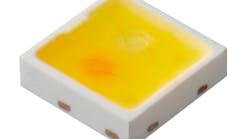These goals were announced at a mid-November 2003 workshop in Washington, DC, sponsored by the DOE's Building Technologies program, which was attended by experts from industry, universities, research institutions, trade associations and national laboratories.
The workshop was held to launch a concerted effort by DOE to accelerate advances in SSL technology using both LEDs and OLEDs. The DOE will consist of a Core Technology Research thrust, involving academia, national laboratories and research institutions, and a Product Development thrust, conducted by industry. A government-industry partnership will also be established to identify core technology needs.
As a precursor to this, various sessions were held at the workshop to clarify and prioritize research needs and objectives. The DOE, which already funds a number of R&D projects relating to both LEDs and OLEDs, expects to release competitive solicitations in the near future.
Reports
At the workshop, David Garman, Assistant Secretary for Renewable Energy and Energy Efficiency, released two new DOE reports authored by Navigant Consulting.
One study analyzes the energy savings achieved by using LEDs in a range of niche applications, such as traffic signals and automotive ("Energy Savings Potential of LEDs in Niche Lighting Applications"), while the other estimates the potential future energy savings from the use of solid-state lighting in general illumination ("Energy Savings Potential of Solid-State Lighting in General Illumination Applications").
Garman said that lighting currently accounts for 8% of US energy consumption, and 22% of the electricity. If solid-state lighting achieves its price and performance targets over the next two decades, this will remove the need for more than 30 percent of the estimated lighting energy consumption. In turn, this will represent billions of dollars of savings for consumers.
Potential energy savings
According to the niche applications study, energy savings to date from LEDs exceed the power produced from one large electric power plant - more than 8 terawatt-hours (TWh). The use of LEDs in automotive lighting applications saves 41 million gallons of gasoline and 142 million gallons of diesel fuel annually. However, if the entire fleet of automobiles, trucks and buses were to convert to LED lighting, 1.4 billion gallons of gasoline and 1.1 billion gallons of diesel fuel could be saved each year. In gasoline, that is the energy equivalent of 30 days of oil flow in the Alaskan pipeline at full capacity; and, in diesel, that represents 12 days of national consumption.
General illumination
When solid-state lighting technology penetrates the general illumination market, the savings become even more significant. The report considers two scenarios ? one where the technology receives a moderate national investment of $50 million per year, and an accelerated scenario based on an investment of $100 million per year. Solid-state lighting achieves different cost, efficiency and durability targets under each scenario.
Under the moderate investment scenario, in 2025 the energy saving associated with solid-state lighting will total approximately 114 TWh, or the equivalent electrical output of about 14 large power plants. Under the accelerated investment scenario, in 2025 the total energy saving is nearly three times higher, at 326 TWh.
From 2005 to 2025, the cumulative energy savings under the moderate and accelerated scenarios are 505 and 1848 TWh, respectively. This latter figure equates to electricity bill savings of more than $120 billion over that time period.




